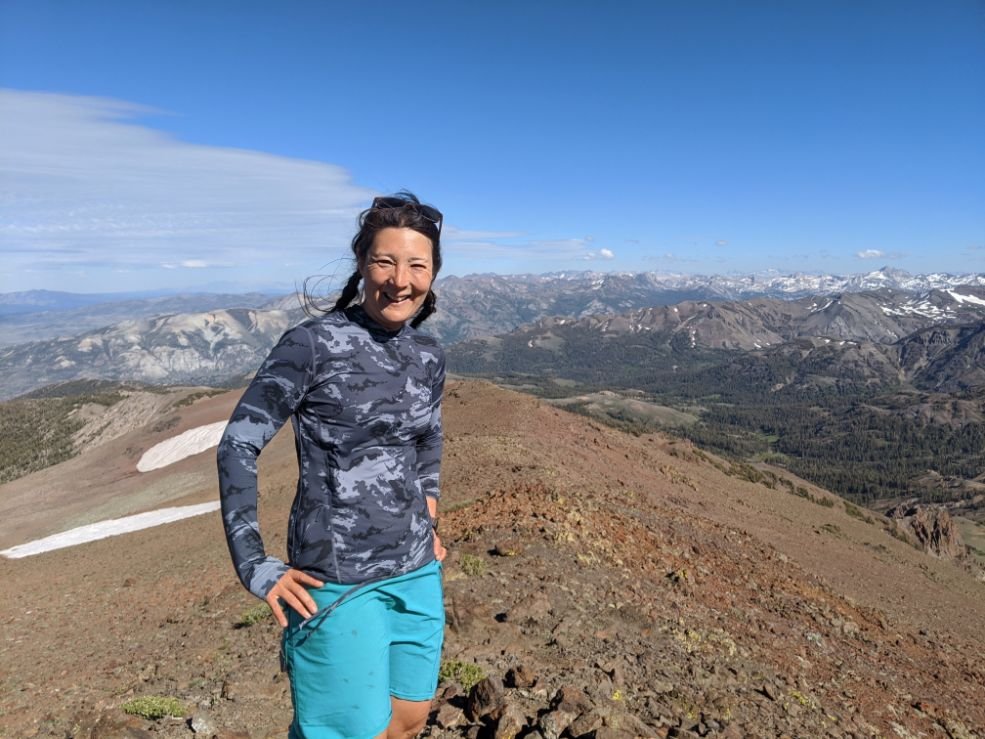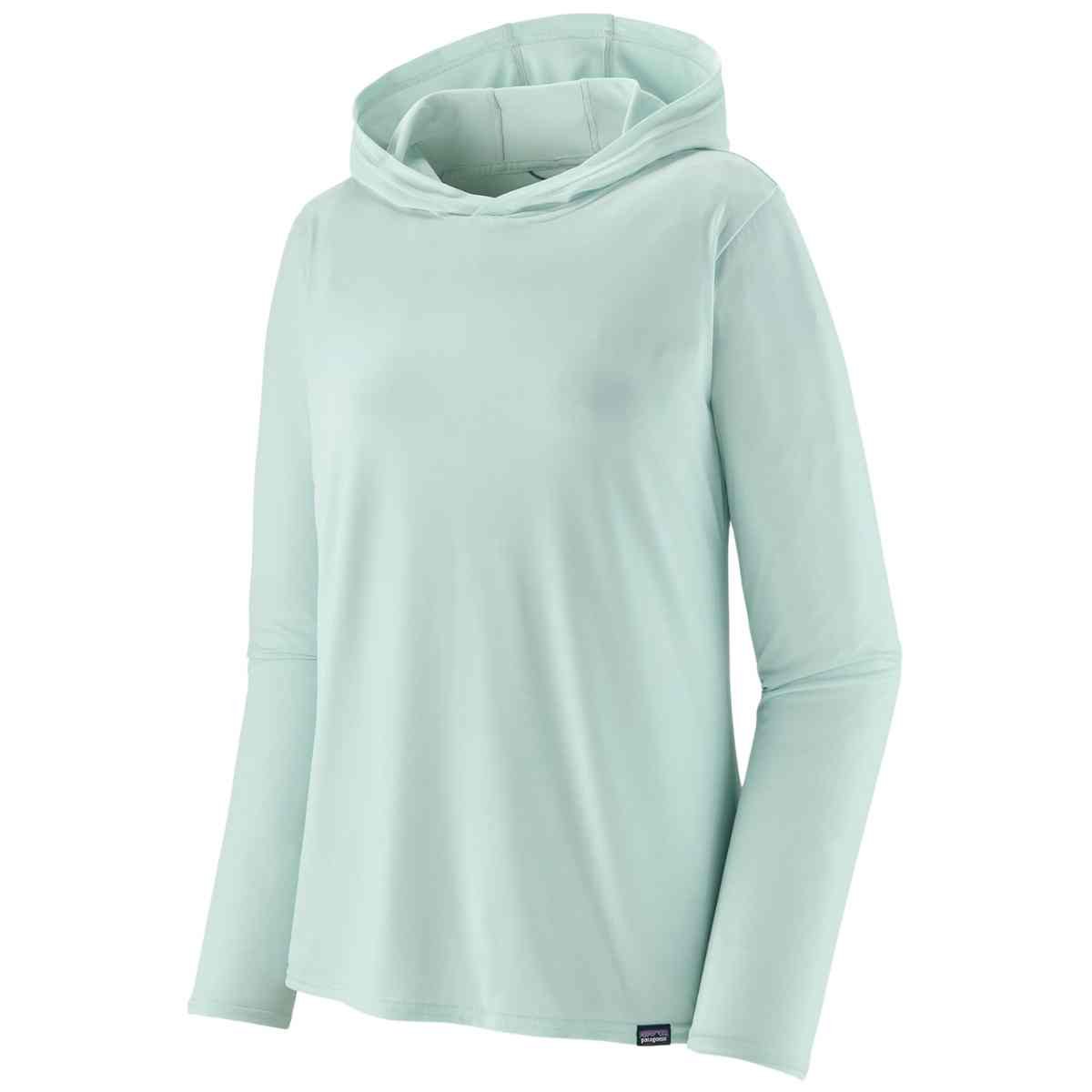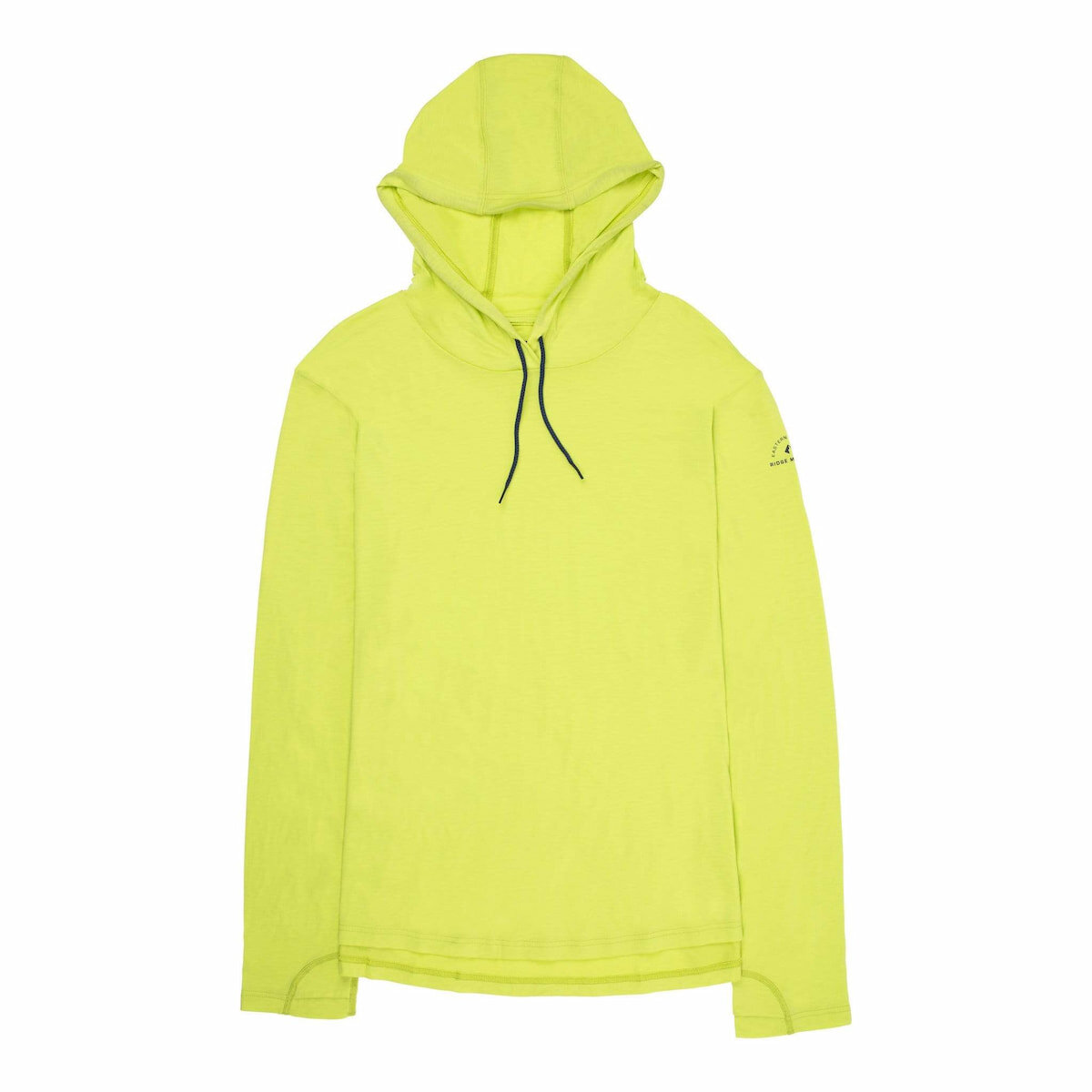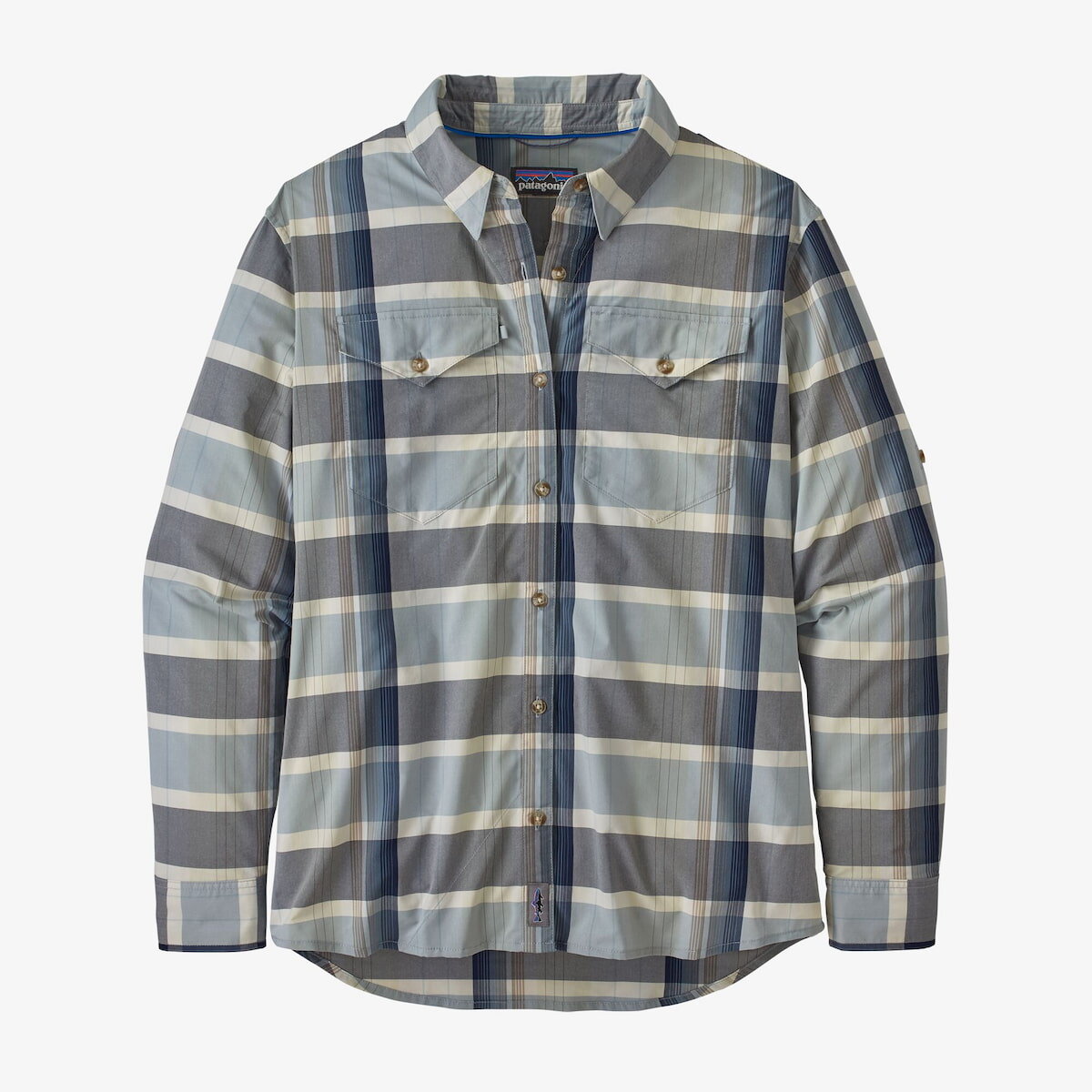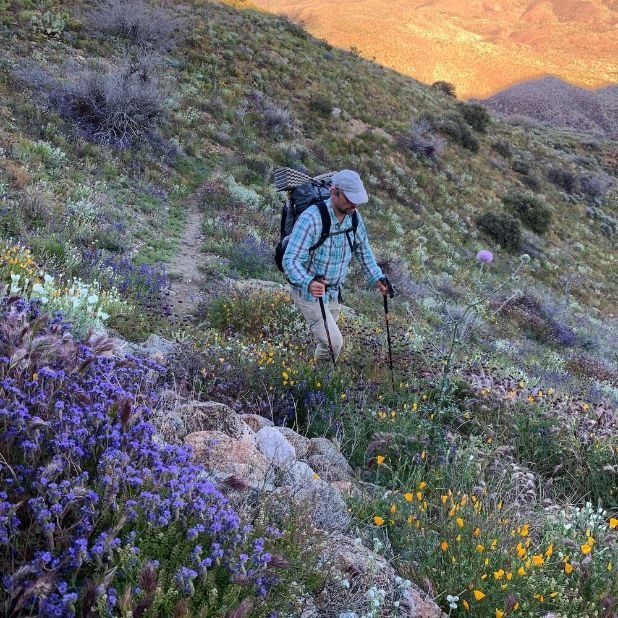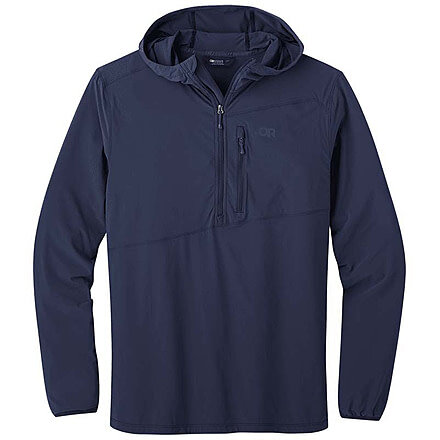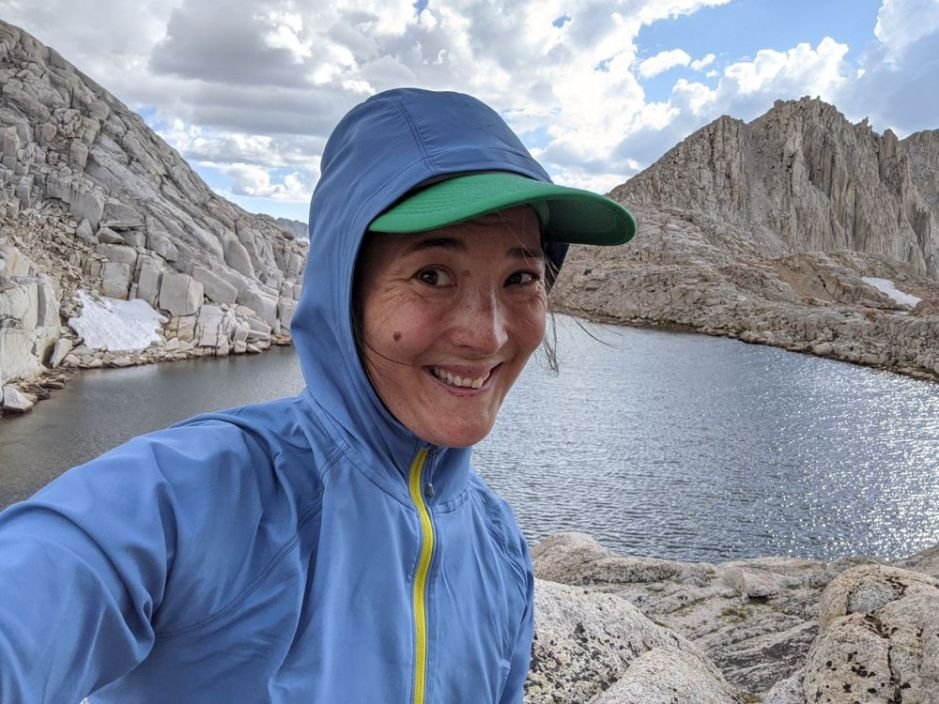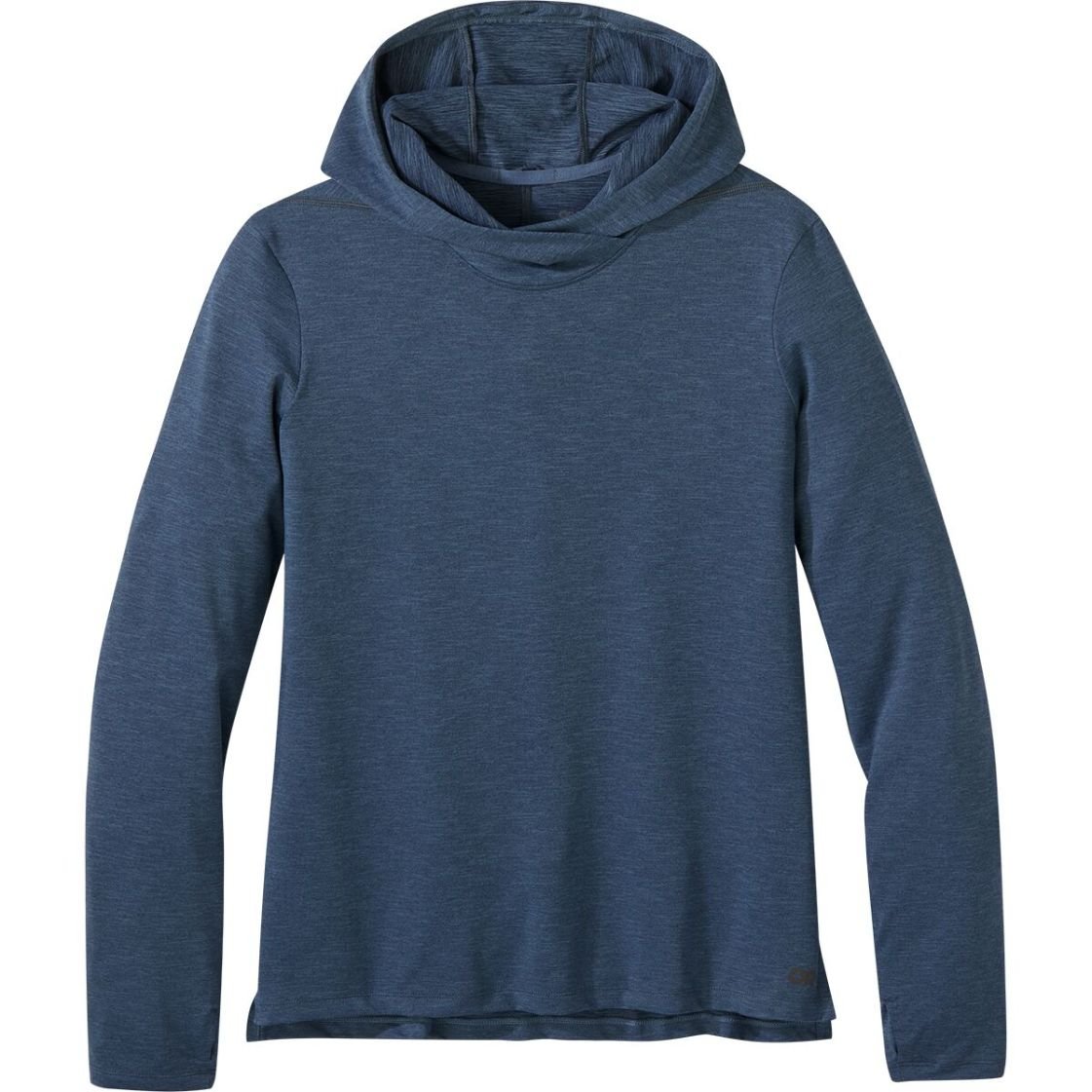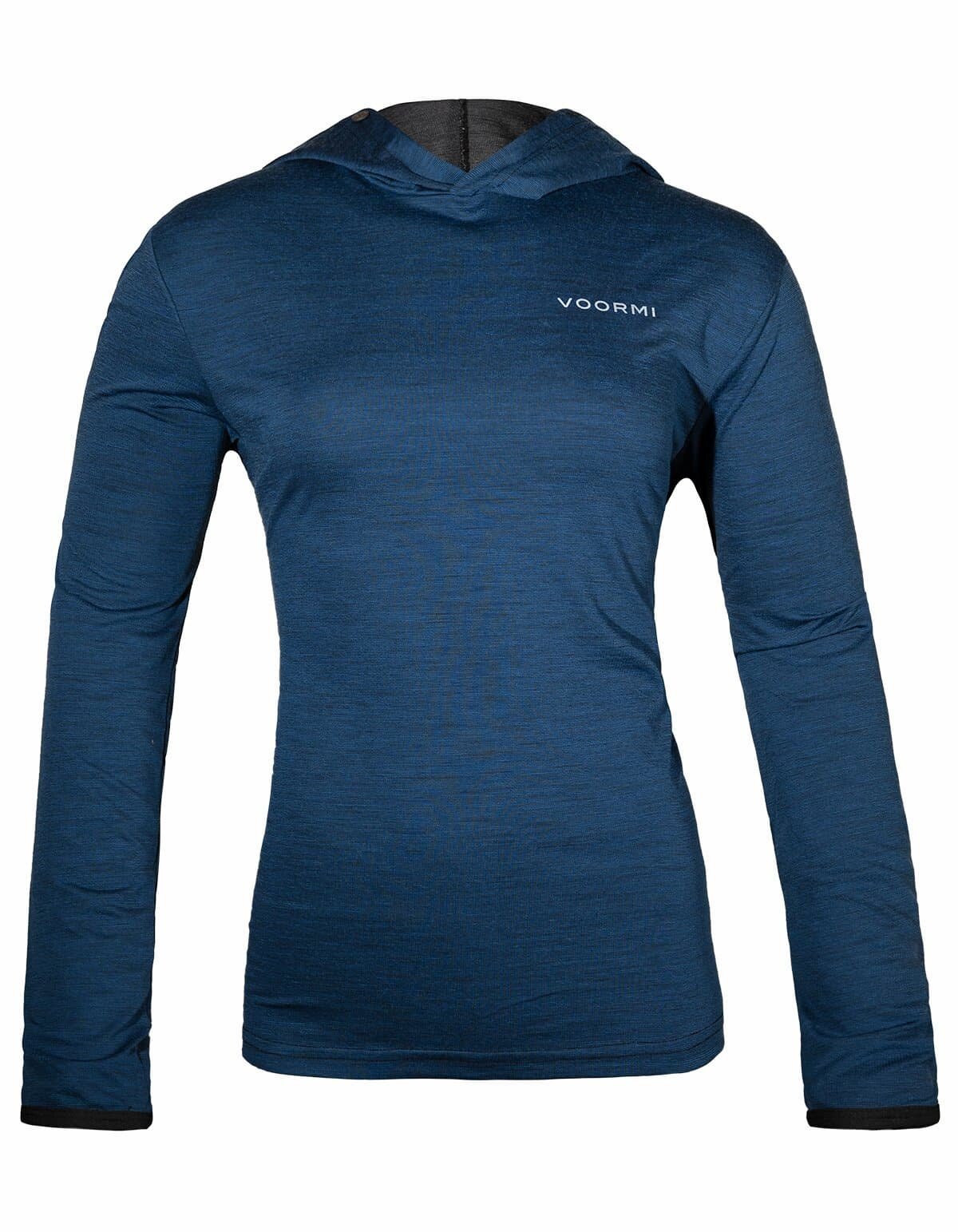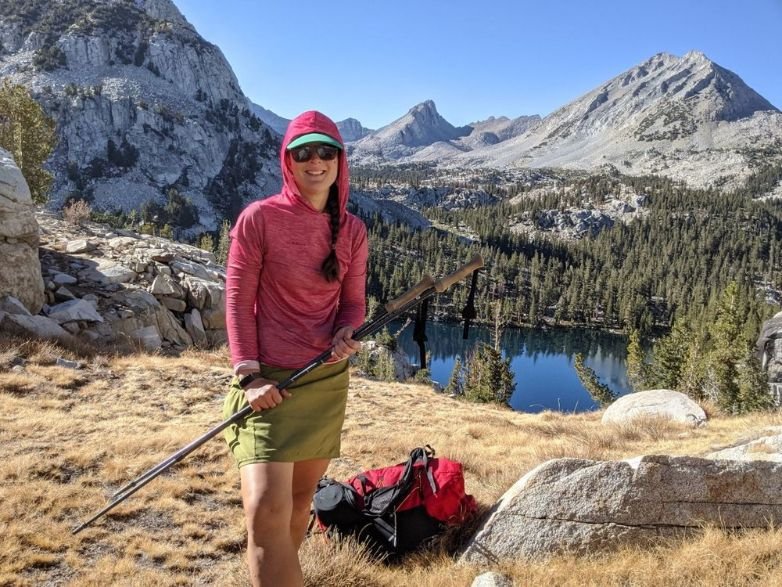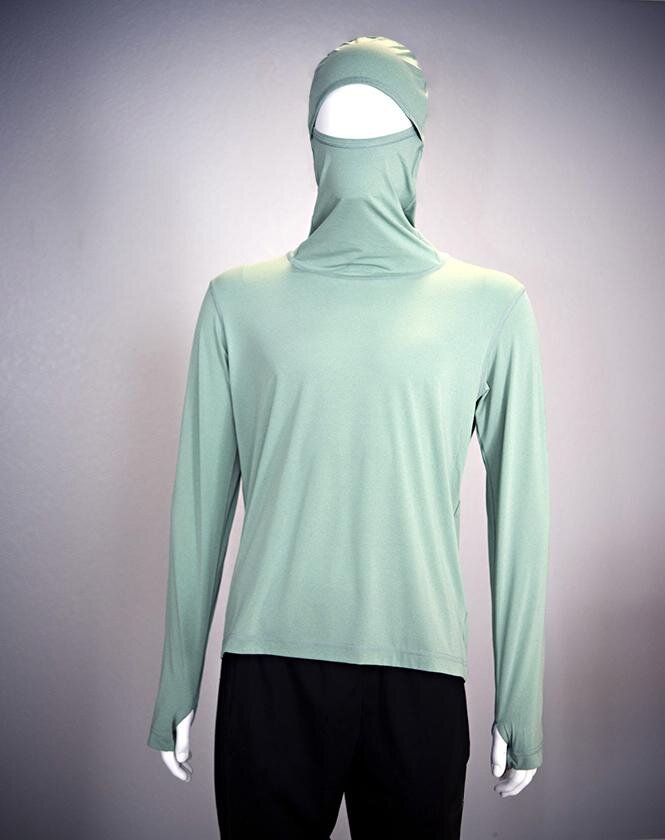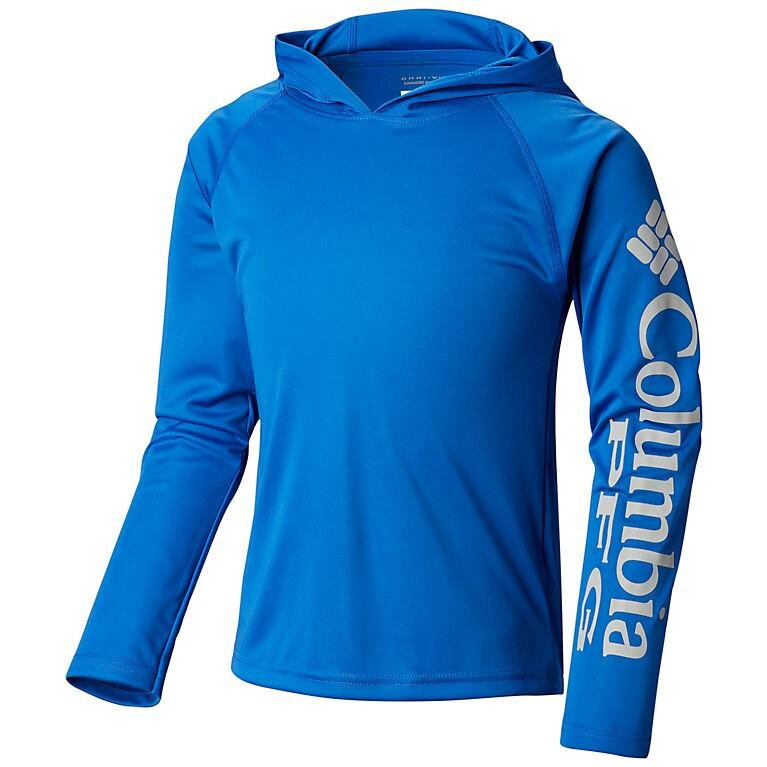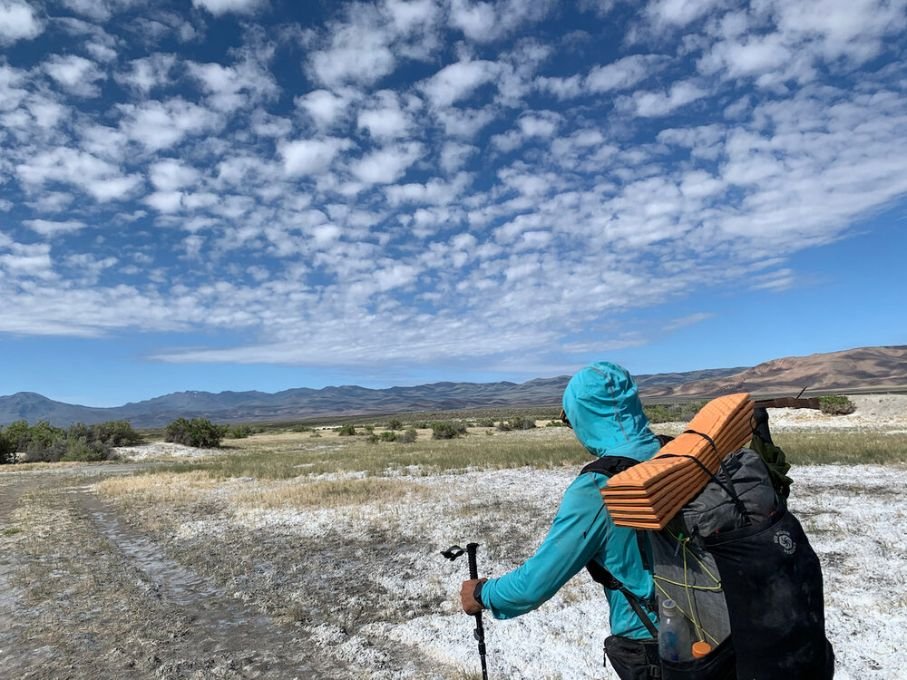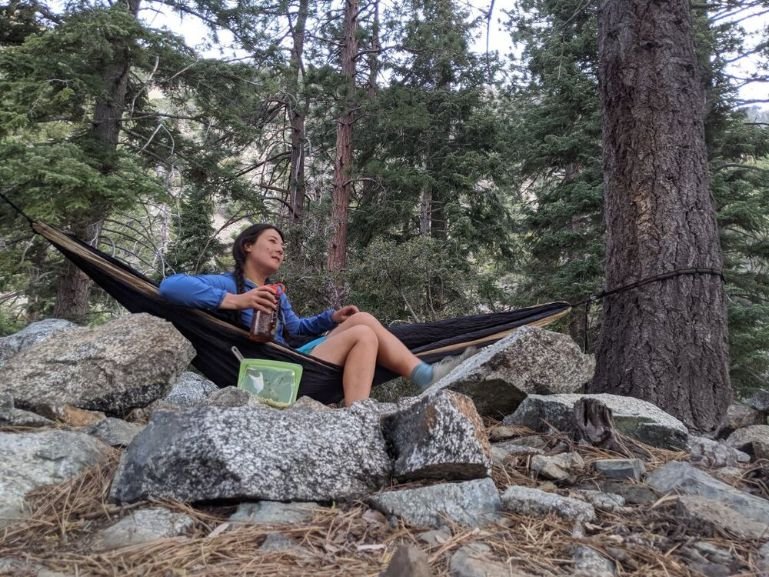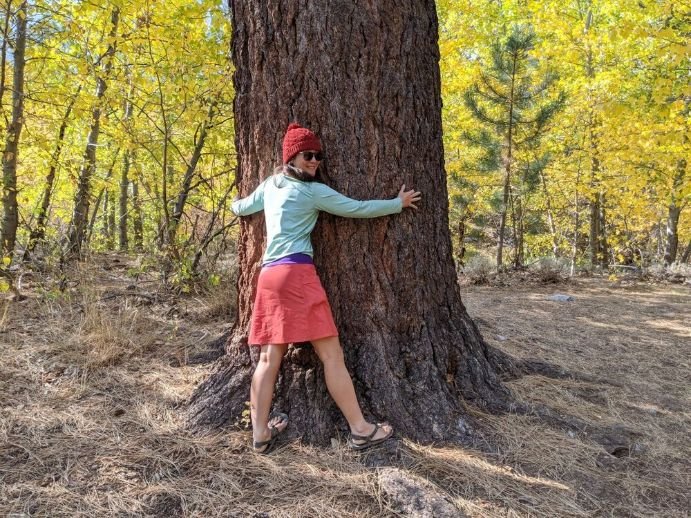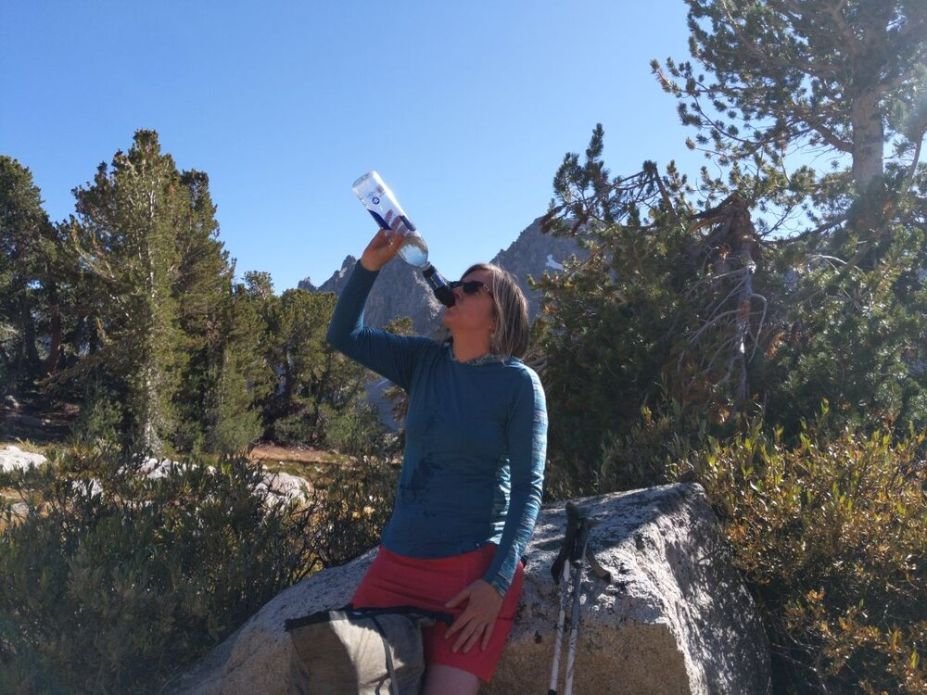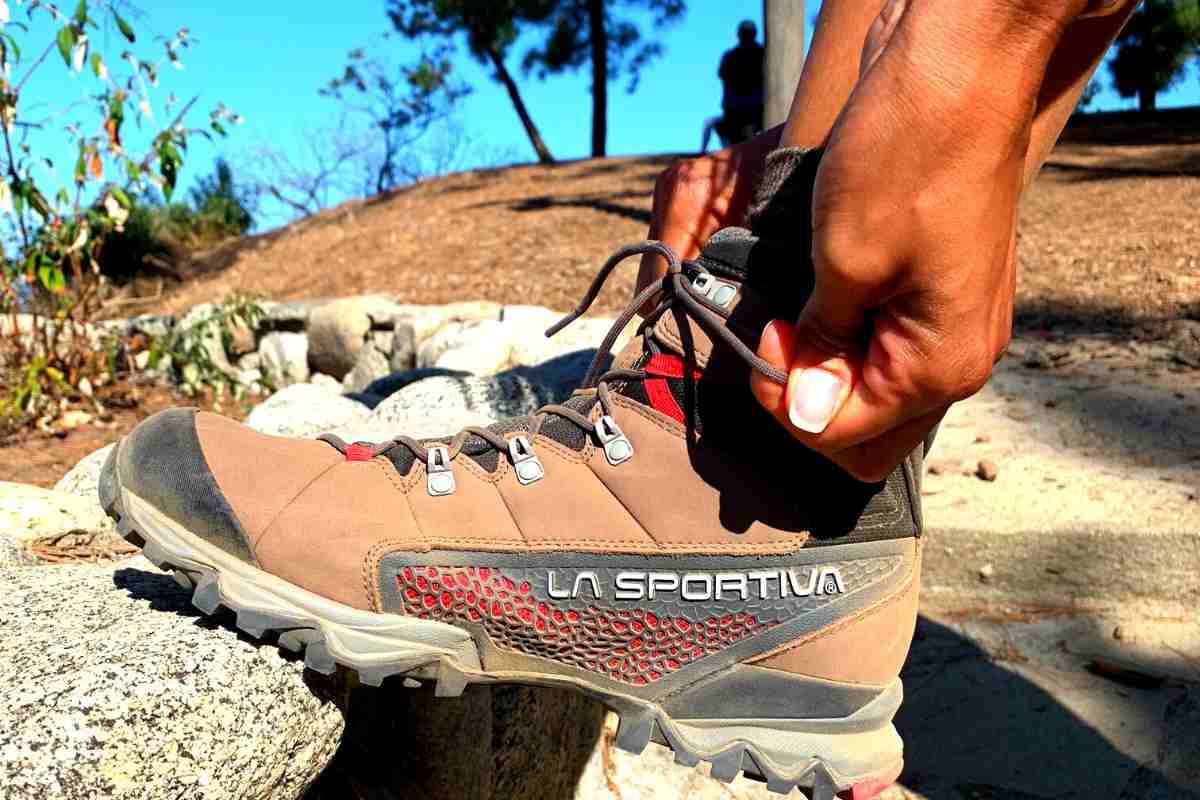Best Sun Shirts of 2024
sun hoodies for UPF protection from the sun’s harmful uv rays
May 6th, 2024
Home > Gear Reviews > Apparel
Whether you’re hiking, biking, or spending a day on the river, you’ll need to protect yourself from the sun’s harmful rays. Sun protective shirts are UPF-rated long sleeves with hoods designed to keep the UV rays off your skin, wick away sweat, and help you stay comfortable.
I'm a professional hiker who previously held the Fastest Known Time on the 2,181-mile long Appalachian Trail. I log in a thousand miles of hiking each year at high altitude on mountains in sunny California, where I live. For this guide, I tested 20+ sun shirts on summits, backpacking trips, thru-hikes, and camping trips in Joshua Tree to find the best UV protection.
There’s a huge variety of sun protective clothing on the market with many different features — hoods, thumb loops, and technical fabric. Our guide to the best sun shirts on the market will help you decide which one is right for you.
Related: Best Sun Hats for Hiking
Read more: Best Running Hats
We create reader-supported, objective gear reviews independently selected by our editors. This story may contain affiliate links, which help fund our website. When you click on the links to purchase gear, we may get a commission — without costing you an extra cent. Thank you for supporting our work and mission of outdoor coverage for every body! Learn more.
Sun Shirt Comparison Tables
Men’s
| SUN SHIRT | TREELINE AWARD | UPF | FIT | HOOD? | THUMB LOOPS? |
|---|---|---|---|---|---|
| Mountain Hardwear Crater Lake Hoodie | Best Overall Read why |
50+ | Standard Fit | Yes | Yes |
| Patagonia Capilene Cool Daily Hoodie | Best Shirt for Hot Weather Read why |
17-45 | Standard Fit | Yes | No |
| Ridge Merino Solstice Hoody | Best Merino Sun Shirt Read why |
30+ | Relaxed Fit | Yes | Yes |
| Jolly Gear Triple Crown Button Down | Best Sun Shirt for Hiking Read why |
50 | Relaxed Fit | Yes | Yes |
| Patagonia Sun Stretch Shirt | Best Fishing Sun Shirt Read why |
30+ | Relaxed Fit | No | No |
Women’s
| SUN SHIRT | TREELINE AWARD | UPF | FIT | HOOD? | THUMB LOOPS? |
|---|---|---|---|---|---|
| Mountain Hardwear Crater Lake Hoodie | Best Overall Read why |
50+ | Standard Fit | Yes | Yes |
| Patagonia Capilene Cool Daily Hoodie | Best Shirt for Hot Weather Read why |
17-45 | Standard Fit | Yes | No |
| Jolly Gear Triple Crown Button Down | Best Sun Shirt for Hiking Read why |
50 | Relaxed Fit | Yes | Yes |
| Patagonia Sun Stretch Shirt | Best Fishing Sun Shirt Read why |
30+ | Relaxed Fit | No | No |
| Ridge Merino Solstice Hoody | Best Merino Sun Shirt Read why |
30+ | Relaxed Fit | Yes | Yes |
Curious about Sun Protection? See our Sun Protection & Hydration page:
The Winners: 6 Best Sun Shirts
Best Long Sleeve Sun Shirt: Mountain Hardwear Crater Lake Hoodie
UPF: 50+
Fit: Standard Fit
Material: 88% polyester/12% elastane
Hood/Thumbloop: Yes/Yes
Sizes: XS - 3X
What we liked: lightweight, soft fabric, hood, thumbholes, plus size availability, most breathable sun shirt on hot days
What we don't like: drawstring on bottom
For a lightweight, affordable, and highly UPF-protective sun shirt, we think the Mountain Hardwear Crater Lake Hoodie is the best of all worlds. With a UPF rating of 50+, the lightest and thinnest fabric we tested, and sizes ranging from XS-3X, the Crater Lake hoodie is everything we want in a sun shirt. The Mountain Hardwear Crater Lake Hoodie is winner for Best Lightweight Sun shirt, Best Sun Shirt for Hot Weather, and Best Plus Size Sun Shirt. It racked up so many of our awards that we decided to call it Best Sun Shirt Overall.
Compare Prices Of The Mountain Hardwear Crater Lake Hoodie
Men's
Women's
Treeline’s editor Liz Thomas finished her PCT end-to-end hike wearing the Crater Lake Hoodie. Here, she’s wearing it on an off-trail side peak in the northern Sierra.
Fabric
The Mountain Hardwear Crater Hoodie's secret sauce is in the fabric: It has 55 UPF protection fabric. It has the thinnest fabric we tested for this story. Of all the sun shirts we tested, it is the one that feels the least hot (aside from those literally made with cooling fabric).
The Crater Lake dries among the quickest of the shirts we tested, making you feel cool as the sweat dries through the process of evaporative cooling. The Crater Lake has among the most stretch of the sun shirts we tested, which is ideal for mobility when climbing, scrambling, or doing steep off-trail.
Design
Design-wise, the Crater Lake hoodie checks all the boxes: It has thumb holes to help protect the top of your wrists from sun exposure. The hood has a drawstring that stays in place and is generous enough to be helmet-compatible.
One thing about the design we're less thrilled about is the draw string at the bottom of the women's version (doesn't exist in the men's). While this may allow a more flattering look, the string gets in the way while going to the bathroom and gets tangled up in packs. Of course, this is an age-old problem for all sweatshirts with strings–but the men's shirt seems to be just fine without a drawstring.
That being we hiked and slept in this shirt, and at night, preferred the drawstrings to the feel of a plastic toggle or other fasteners that otherwise would be in that spot. If it really bothers you, just pull it out.
Treeline Review writer Felicia Hermosillo testing the Mountain Hardwear Crater Lake Sun Hoody on the South Sierra High Route.
Testing
Treeline writer Felicia Hermosillo spent a summer wearing this UPF shirt on a thru-hike of the Southern Sierra High Route and while climbing all of Colorado's 14ers (14,000-foot peaks). At altitude, sun protection is essential.
Durability
In a previous version of this story, we wrote that we were concerned about the long-term durability of the thin fabric. Since then, Mountain Hardwear has updated the Crater Lake Hoodie to address the issue in the earlier model. After conducting a year's worth of further testing, we also believe the initial shirt we tested was from a bad batch. This year's model has survived weeks straight of wearing it backpacking and climbing with no issues.
Value
One of the things we liked the most about the Crater Lake is the value for the price. There are less expensive sun shirts out there, like the Baleaf that is our Best Budget winner. But the UV protective fabric on the Crater Lake is much thinner and more breathable. Unlike the Patagonia Cool Lite Hoodie, the hood stays in place.
Sizing and other options
We also like that the Crater Lake is available in various sizes, from XS to 3X, and in various cuts. The Crater Lake is available in tanks, tees, and crop tops. Some people want to wear those styles and we get that.
While we don't think those designs are the best for sun coverage, we think getting any UPF 55 protection is better than the UV protection offered by cotton fabric.
Who else likes it
The Crater Lake Hoody is a best seller and top-rated at REI, Backcountry, and Amazon. It was the overall winner at Outdoor Gear Lab, praising it highly for breathability. We agree, and this has become our go-to hoody for warm days where sun protection is essential.
Best Shirt for Hot Weather: Patagonia Capilene Cool Daily Hoodie
UPF: unlisted but previously tested at 17-45 (average 34)
Fit: Standard Fit
Material: 100% recycled bluesign certified polyester
Hood/Thumbholes: Yes/No
Sizes: XS-XXL (women's), XS-3XL (men's)
What we like: moisture wicking, relatively affordable, bluesign recycled fabric, sewn Fairtrade factory
What we don't like: no official UPF rating, no thumbholes, hood isn't secure
The Patagonia Capilene Cool Daily Hoodie has and continues to be the standard for sun shirts among PCT and CDT thru-hikers, who hike day after day in hot temperatures. We spent years testing the Patagonia Cool Daily Hoodie and loving almost everything about it — from its quick drying fabric to its minimalist design and reasonable price.
The Patagonia Cool Daily Hoodie hits all the marks for what we look for in a sun shirt: lightweight, comfortable fabric, quick-drying, and full coverage. It's among the thinnest and lightest weight fabrics on the sun shirts we tested and dries among the most quickly, too.
Compare prices of the Patagonia Capilene Cool Daily Hoodie
Women's
Men's
Hiking with the Patagonia Cool Daily Hoodie in the autumn in the Sierra.
Fabric
The fabric is thin, lightweight, and soft and feels cooling. It's got a little less stretch than the Crater Lake hoody, but is fitted so as to leave a small gap of air between your skin to get some flow.
The Cool Daily is also treated with a Polygiene anti-odor technology called HeiQ® Fresh Durable Odor Control, which seemed to work even after a week of continuous use. The fabric is 50% recycled, bluesign certified for environmentally-friendly dying, and sewn in a Fair Trade factory.
Features
We’ve used the Cool Daily on hundreds of miles of hiking and backpacking over many months and have found it to be a reliable and durable shirt to keep you covered from the sun.
We love the minimalist design on the Cool Daily but recognize it has some drawbacks. We like that there are no drawstrings to get caught in backpack straps, climbing equipment, or the washing machine. But the hood doesn't have a way to secure it in the wind, which Outdoor Gear Lab dinged it for.
We also wish this shirt had thumb loops or thumb holes to cover the top of your hands, as was offered in the still discontinued Patagonia Tropic Comfort. The two models are almost identical except for those features.
Sun protection
In previous editions of this story, we planned to make the Capilene Cool Daily our overall winner. But before we published, Patagonia voluntarily recalled the Cool Daily Hoodie because not all batches were living up to their reported UPF 45. Last year, the shirt has been re-released, but without a reported UPF rating. The previous editions were testing between 17 and 45 with an average of 34.
But Patagonia states “even at 17 UPF, the products block 92% of the sun’s ultraviolet rays.”
And ultimately, we think when it is hot, if your choices are wearing a tank top or wearing something comfortable and long sleeve with 17 UPF, you should go with the 17 UPF. The Capilene Cool Daily is so comfortable, we think you’ll choose sun protection, even on a hot day.
Despite the lack of UPF-rating, it is still immensely popular. And after another year of testing and finding that we continuously reach for this shirt when the temperatures are hot, we decided to give it the award we think it deserves: best sun shirt for hot weather.
BEST Merino WOOL SUN SHIRT: RIDGE MERINO SOLSTICE HOODIE
UPF: 30+
Fit: Relaxed Fit
Material: 87% Merino Wool 13% Nylon
Hood/Thumbholes: Yes/Yes
Sizes: XS-XXL
What we liked: soft fabric, moisture wicking, durability, lots of airflow, merino's antibacterial properties keep down odor
What we don't like: drawstrings can get caught in backpack straps
After three years of testing, the Ridge Merino Solstice hoodie is still our go-to sun shirt due to its comfort and coverage. The Solstice Hoodie has a loose yet flattering fit (in both men’s and women’s models) that has plenty of airflow, preventing overheating. What has us reach again and again for the Solstice over other sun shirts is its comfort with a soft merino wool blend that never felt itchy.
In addition, the Ridge provides full coverage with a high neckline, adjustable hood, and thumbholes that keep the sleeves over the backs of hands. Best yet, it’s affordable for a wool shirt, matching the price of many of the synthetic sun shirts we tested.
VIEW THE RIDGE MERINO SOLSTICE HOODIE
Author Liz Thomas testing the Ridge Merino Solstice Sun Hoody on a 1000 mile southbound section hike of the Pacific Crest Trail with Mt. Thielsen in the background. Photo courtesy Liz Thomas.
How we tested
We backpacked 500 miles of the PCT using the Ridge Merino Solstice. Besides getting dirty (which would happen to any shirt), it showed no wear. The fabric is soft and does not restrict movement, reminding us of other merino sun hoodies we’ve tested—but at half the price.
Coverage
The Ridge Merino Solstice was long enough to provide complete protection without feeling loose enough to get in the way.
Unlike the button fasteners found on other sun shirts, the Solstice has a drawstring hood that allows exacting precision for securing the hood. The Ridge merino blend never felt itchy or hot. Instead, it felt more like cotton.
Ridge Merino is a small and relatively new company, but the Solstice Hoodie has made splashes in Adventure Journal. At Treeline Review, we keep our eyes out for new brands with ideas that could change the market — and merino sun shirts are one of them.
Design updates
The newest model updates the drawstring so that it no longer gets caught in the wash or gets in the way. This fixes one of our only issues with this.
How are merino sun shirts in the heat?
Breathability on this merino sun shirt is excellent. I find it ideal for sunny and exposed hikes at altitude such as in the Sierra (which makes sense given that Ridge is based in Mammoth Lakes, CA). It is best for hikes below 80F, but I've worn it above 100F in the Mazatzal Wilderness in Arizona during a record breaking heatwave and actually was pretty shocked by how comfortable it remained. Most amazingly, the shirt was stained across from all my sweat and caked in salt but didn't smell. That's why it made my list of favorite gear from the Arizona Trail.
Best Sun shirt for Hiking: Jolly Gear Triple Crown Button Down
UPF: 50
Fit: Relaxed Fit
Material: 86% Polyester, 14% Spandex
Hood/Thumbholes: Yes/Yes
Sizes: XS-XXL
What we liked: button up allows venting, hood for neck protection, zippered chest pockets hold a phone, stylish, fun patterns and colors
What we don't like: sleeves are short for thumb loops, retains odor, limited supply
Hikers have long dreamed of a sun shirt that is both a button-down shirt and has a hood. Now, that sun shirt is a reality and our winner for Best Hiking Sun Shirt, the Jolly Gear Triple Crown Button Down.
Speaking as a Triple Crowner myself (someone who has hiked the Appalachian Trail, Pacific Crest Trail, and Continental Divide Trail), this shirt is something I’ve been long hoping would be available for hiking and backpacking. Button down shirts like our winner for Best Fishing Shirt are great for venting and looking stylish. But hoods are essential for protecting sensitive skin along the neck and the top of ears that aren’t always protected by sun hats. With the Jolly Gear Triple Crown Button Down, it’s now possible to have both.
Additionally, it has thumb loops and zippered phone pockets, which are always bonuses when we find them on other sun shirts. I tested this shirt on a 300-mile thru-hike of the Superior Hiking Trail as well as day hikes near Ashland, Oregon and was constantly getting compliments on its stylish look. For these features, the Jolly Gear Triple Crown Button Down wins our award for best hiking sun shirts.
View the Jolly Gear Triple Crown Button Down
Women's
Men's
The author on her thru-hike of the Superior Hiking Trail in Minnesota.
Features
The Triple Crown Button Down is filled with thoughtful features that were developed over many miles of thru-hiking and thinking that other shirts were almost perfect, but needed a few additions.
It’s quickly become a popular shirt on long trails for its stylish and fun designs—and more importantly, practical features.
Fit
As far as fit goes, the length in the torso and relaxed fit were exactly what I needed for staying down while wearing a backpacking backpack and venting heat while moving. The sleeves could be longer. I have a negative 2 ape index, meaning my arms are shorter than my height. Still, I had trouble getting my thumbs to reach the thumb loop holes. As Jolly Gear is a relatively new company, I hope this is fixed in future iterations.
After putting a thru-hike into this shirt, I’ve noticed that the polyester blend fabric retains odor. I’m not going to hold it against this shirt, though. This is common for any synthetic sun shirt and frankly, any shirt that one thru-hikes in.
Lastly, as a small company, supply is limited. Last year, when I got my shirt in June, they were out of my preferred color. Be sure to get yours early in the season!
For more of our sun-related gear recommendations, see these popular Gear Guide stories:
Best Sun Shirt For Fishing: Patagonia Sun Stretch Shirt
UPF: 30+
Fit: Relaxed Fit
Material: 52% recycled nylon/48% T400® polyester plain weave with mechanical stretch
Hood/Thumbholes: No/No
Sizes: XS - 3XL
What we like: good pockets, quick dry, lightweight fabric, stretch, ability to unbutton for extra airflow, sunglasses wipe, plus size availability (men's only)
What we don't like: price
Some folks prefer to spend their backcountry time in button-up shirts or without a hood. For anglers, hoods can reduce visibility and can be annoying while casting. After much research and testing, we’ve found that Patagonia’s Sun Stretch Shirt — marketed as a fishing shirt — provides coverage while still feeling comfortable during movement, including bigger casts. We award the Patagonia Sun Stretch the award for Best Sun Shirt for Fishing for its full coverage and ample pockets. That being said, we’ve tested this shirt over thousands of miles of hiking and backpacking and think this fishing shirt is an excellent sun shirt for other outdoor activities, too.
View The Patagonia Sun Stretch Shirt
Women's
Men's
Treeline writer Mike Unger testing the Patagonia Sun Stretch sun shirt on the Arizona Trail. Photo courtesy Naomi Hudetz.
Fabric
The Patagonia Sun Stretch Shirt ticks all the boxes for quick-dry, lightweight fabric, with plenty of stretch for movement and enough airflow to prevent overheating while also snagging some style points. We love the size availability in men's–up to 3XL. It'd be great if they also offered the same size range in women's.
Best yet, the material of the Sun Stretch is 55% recycled and blue sign certified.
Button-up sun shirts as a category suffer from fabric that doesn’t stretch or is too thick. There are a lot of slick-looking button-up sun shirts out there — many with UPF 50 sun protection fabric. Most button-up sun shirts are great for looking stylish while hanging out at the bar patio, camp, or anywhere in Colorado.
But to keep that “in place” sleek design, the fabric sometimes has to be thicker or less flowy than we’d want in a sun shirt. As a result, many button-up shirts didn’t meet the performance criteria we set for a sun shirt.
How we tested
The Patagonia Sun Stretch avoids the most common problems of button-up sun shirts. To test the Patagonia Sun Stretch, our writers and editors have thru-hiked the 800-mile long Arizona Trail in the Patagonia Sun Stretch as well as the 2,650-mile-long Pacific Crest Trail. On both trails, they found the fabric to be quick-dry and stretchy without restricting movement. In addition, it doesn’t feel overly thick like the similarly-designed REI Sahara.
Pockets
Another perk of the Patagonia Sun Stretch is its abundance of pockets. Designed as a fishing shirt, the Sun Stretch was meant for keeping fly fishing accessories accessible. The feature we liked the most is the sunglasses lens cleaner. When you’re on the water, glare from the sun can make it difficult to see where to cast. If you’re wearing a sun shirt, we recommend you also wear sunglasses.
For hikers and climbers, it’s great for snacks or a phone. It also has sleeve tabs, so you can button up your sleeves if you want to convert your long sleeve shirt into a short sleeve.
Who else likes it
The Sun Stretch is also lauded by Insider. It’s a favorite with customers, too, scoring 4.8 out of 5 ratings (out of 54 reviews) on Patagonia’s website and overall 5-star reviews at REI and Backcountry.
Best Sun Shirt for Climbing: Outdoor Research Astroman Air Sun Hoodie
UPF: 50+
Fit: Regular Fit
Material: bluesign® approved 84% nylon, 16% spandex
Hood/Thumbholes: Yes/Yes (thumbloops)
Sizes: XS-XL (women's), S-3X (men's)
What we like: extreme durability for using during crack climbs, very stretchy and sized for excellent airflow, extra long zipper for lots of aeration, climbing-friendly features like fits in a pocket with a loop for your harness
What we don't like: fabric can feel warm
Designed as a mid-layer sun shirt, the Outdoor Research Astroman Sun Hoody seems out of place in a category of sun shirts dominated by against-the-skin layers. But the Astroman has become one of our favorite active layers.
As the name implies, it was designed as a technical, durable, stretchy, form-fitting layer for rock climbers with a UPF 50+ rating. Its namesake climb is a difficult 1,000-foot crack climb on Washington Column in Yosemite Valley.
We don't find the dense and stretchy fabric as comfortable next to the skin as the other sun shirts we’ve tested (though we still wear it often against the skin, too). So instead, we highly recommend it as a put-on, take off and stow top layer for rock climbers, alpine scramblers, and technical ridge walkers.
The Astroman fits snug for the size, perfect for jamming your arms in cracks while rock climbing. It's available up to 3XL in men's, though we wish the same availability existed for women's sizing.
COMPARE PRICES OF THE OUTDOOR RESEARCH ASTROMAN SUN HOODIE
WOMEN'S
MEN'S
Author Liz Thomas testing the Outdoor Research Astroman Sun Hoody on a alpine climbing/scrambling trip in the Sierra. Photo courtesy Liz Thomas.
Fabric
We love the Astroman at altitude and on cool days, but it is overly warm for hot weather. We suspect this warmth was due to the tight-knit of the high UPF fabric. The fabric is also designed to be durable enough to jam your arms in cracks without ripping. The Astroman may be the only shirt we tested that we would feel confident doing that with.
Ventilation
Still, the Astroman has some features to mitigate overheating: a generous zipper in the front allows you to vent additional heat. It was among the fastest sun shirts to dry in our quick-dry tests and wicked moisture away well.
Climber-friendly features
The Astroman also has several other climber-friendly features. For example, the shirt stuffs into the chest pocket, with room to spare. (The women's version doesn't have a chest pocket but instead as very generously-sized side pocket that operates the same way).
It also has a clip-in loop to make it easy to attach to a harness. We also carried a snack inside the pocket while climbing.
Because the hood is designed to fit nicely over a helmet, our tester Brandon has added the Astroman to his cool weather bicycling costume, replacing his trusty Patagonia Houdini. The Astroman is stretchier, more form-fitting, and quieter in the wind.
Updates in the newest version
The newest version of the Astroman is renamed as the Astroman Air. The goal is to help with breathability and venting, while maintaining extreme stretch and a high UPF rating.
It keeps the 3-panel hood for use with a helmet but has added some strategically positioned laser-perforated holes for more breathability.
Who else likes it
The Outdoor Research Astroman is a favorite at Outdoor Gear Lab, Men’s Journal, and Gear Patrol. In addition, it has 4.8 out of 5 stars on Outdoor Research’s website, scoring similar customer reviews from Moosejaw customers for both the men’s and women’s versions.
While the Astroman Hoodie isn’t the sun shirt for every situation, we think it excels in its niche as a climbing sun shirt. You’d be hard-pressed to find a more durable, lightweight, sun-protective shirt with stretchiness suitable for climbing.
Best Budget Hooded Sunshirt: Baleaf Sun Shirt
UPF: 50+
Fit: Relaxed Fit
Material: 100% Polyester
Sizes: X-3XL (women's), XS-3XL (men's)
Hood: Hooded and non-hooded versions are available
What we liked: price, generous hood, size and color availability
What we didn't like: thicker fabric didn't breathe as well as other sun shirts
Finding a budget sun shirt that fits well proved a challenge. The Baleaf sun shirt was not only $10 less than the closest competitor, but it offered an excellent balance of features and coverage. It’s available in 29 colors from size XS to 3XXL in men’s and women’s from S to 3XXL in 7 colors.
Despite the budget price, the Baleaf sun hoody has features found in the most expensive sun hoodies we tested, such as thumb holes to protect the back of your hands from the sun.
Compare Prices Of The Baleaf Sun Hoodie
Women's
Men's
Tester Brian Davidson wearing the Baleaf hooded sun shirt in the southwest desert on a hike at Mesa Verde National Park. Photo courtesy Liz Thomas.
How we tested
Baleaf is a brand known for quality, budget apparel and is also a winner in our Best Shorts for Thru-hiking guide. To test the Baleaf shirt, we took in camping and backpacking in the desert southwest in June—not a cool time of year. Our journeys took us to Mesa Verde National Park, which is at altitude and has no shade. For the price, the Baleaf stayed surprisingly cool and wicked sweat well.
Features
As mentioned above, the Baleaf sun hoody has features found in the most expensive sun hoodies we tested: thumb loops, neck gaiters, and hidden pockets.
The hood on the men’s version is similar to that on the Patagonia Capilene Cool Daily Hoodie, which is to say it doesn’t have a mechanism to secure it in the wind. However, the women’s version has a fuller coverage hood that is more similar to the neck gaiter style found on the Ushood. The women’s version also has a back pocket with a hidden zipper, which isn’t located in a convenient place for hiking or backpacking, but could be helpful for stashing keys and a wallet (but not a phone).
Alternatives
As much as we like this shirt for cooler weather pursuits, if it gets too hot, this is not the shirt we'd recommend. The fabric is relatively thick compared to other sun hoodies.
For about $10 more, the REI Sahara has the same features with a more refined cut than the Baleaf. It's also made of bluesign approved fabric. So if you're on a budget but have a little more to spend than the Baleaf, consider the REI Sahara Sun Hoodie.
Honorable Mentions
Outdoor Research ActiveIce spectrum sun hoodie
UPF: 50+
Fit: Relaxed Fit
Material: 94% polyester, 14% spandex
Hood/Thumbloops: Yes/Yes
Sizes: XS-XL
What we liked: fabric really does feel cooling, longer back to prevent riding up, generous sleeve length
What we didn't like: cut could be more flattering, the fabric is thicker than we'd expect for a hot weather fabric
The Outdoor Research ActiveIce is a UPF sun shirt made of cooling fabric for sun protection on hot days. I tested this sun shirt peak bagging in Southern California in the summer and found it to be the best cooling sun shirt. Its sleeves are generous. I liked the longer backside of the shirt, which prevented the shirt from riding up with a backpack.
Compare Prices Of The Outdoor Research Activeice Spectrum Sun Hoodie
Women's
Men's
The fabric dries quickly, though it was thicker than other sun shirts we enjoyed wearing in hot weather, notably the Mountain Hardwear Crater Lake Hoody.
The hood doesn't have a drawstring or button, and the fabric is slippery, so it may be more likely to slip in the wind.
As with other cooling shirts we've tested, a downfall of this sun shirt is that it really does feel about 10 degrees cooler than other fabrics. As much as we loved the cooling fabric on warm days, we had some incidents where the weather changed quickly in the mountains. The cooling fabric went from a blessing to a curse.
If you're backpacking, we think you’re better off going with a fabric that regulates warm and cool temperatures well. But if you have checked the forecast, are certain of hot weather, and are out for a day hike, paddle, or bike ride, the Outdoor Research ActiveIce may help keep you cooler.
Voormi River Run Hoodie
UPF: 30+
Fit: Relaxed Fit
Material: 52% wool, 48% polyester
Hood/Thumbholes: Yes/Yes (thumbloops)
Sizes: XS-XL (women's), S-XXL (men's)
What we liked: flattering look, very thin and surprisingly durable, button to fasten hood instead of drawstrings, thumb loops
What we didn't like: itchy, not as high UPF as other sun shirts, may be difficult to get because the company is small
The Voormi River Run Hoodie was described by our writer Dean Krakel as “the best piece of clothing I’ve ever owned.” After hiking almost 2,000 miles of the Continental Divide Trail in this shirt, he bought four more. It was a previous winner for this guide.
We still like this sun shirt, but given the price and abundance of options available, we think there are better sun protection options, especially for the price. The Voormi makes you look good, and it works well as a base layer.
View The Voormi River Run Hoodie
Women's
Men's
Author Liz Thomas testing the Voormi River Run Sun Hoodie on the Sierra High Route. Photo courtesy Liz Thomas.
Manufactured in Pagosa Springs, Colorado, and Bozeman, Montana, Voormi shirts are made from a 100 g/m ultralight wool-synthetic blend that is surprisingly durable and very comfortable. It has a relaxed fit that won’t have you confusing it for a base layer and still looks good on various body shapes.
The River Run hoodie has many small features that we like. Its high neck provides full neck coverage. The generous hood fits over a hat and still protects the side of the neck and ears from the sun. It also has a button to fasten the hood from blowing off your head. The button is a minimalist way of securing the hood, and it sometimes felt tight on the neck, but we still are glad that it is there.
One of the failings of other sun shirts is that sleeves will slip, exposing your hands, but the River Run has elastic wrist cuffs and thumb loops that are well-placed to pull over the top of your hands. In addition, the sleeve and torso length provides ample coverage without being too relaxed.
The Voormi River Run shirt is also a favorite at Backpacker and Adventure Journal. Adventure Journal, in particular, seems to echo our tester in thinking it’s one of the greatest pieces of clothing ever made.
One thing to watch for: The River Run is made of a 100 g/m ultralight wool-synthetic blend called Dual Surface Precision Blend. Outside Magazine called it among the thinnest available on the market. While the light fabric is thin, airy, permeable, and breathable (all of the things we want in a shirt designed for summer use), it is also very thin. This makes it potentially less durable than other sun shirts, especially when it comes in contact with velcro.
Two of our testers attest to the River Run surviving intense, rugged use. One of our testers, a biologist who wears the shirt while surveying for tortoises all day in the Mojave Desert, says he has at least three field seasons of use without signs of wear. His job requires him to bushwhack through spiky plants and under barbed wire fences. Our writer Dean Krakel trail runs, thru-hikes, bikepacks, and mountain bikes in his River Run, barely registering signs of wear.
Testing the Voormi River Run Hoodie on the Sierra High Route.
I, however, wasn’t so lucky in my testing, discovering a hole within a few weeks after a few day hikes. A few other customers talk of the fabric snagging and pilling, though it doesn’t seem common.
It’s also worth noting a few reviewers, including Outdoor Gear Lab, found the material to be initially scratchy. We experienced this at first, but it softened after a wash. However, if you are very sensitive to wool, we recommend going with a sun shirt made of 100% synthetic fibers.
One downside of the Voormi River Run Hoodie is that it’s expensive, with the second highest price tag of any sun shirt we tested (after the Icebreaker). Still, based on our testing and customers’ rave reviews, no one seems to mind the price tag.
Additionally, as a small company that makes shirts in the US, the color and sizing options are more limited than bigger brands. Still, if you can find a color that you like, we think it’s well worth getting one if you intend to spend significant time outdoors.
Ushood Liteside Sun Shirt Unisex
UPF: 50+
Fit: Flattering Fit
Material: 81% Polyester, 19% Spandex
Hood/Thumbholes: Yes/Yes
Sizes: Kids' to 3XL
What we liked: excellent coverage, made in the US, variety of colors and sizes
What we don't like: thicker fabric, doesn't breathe as well as other sun shirts
The Ushood Liteside Sun Shirt is a summer twist on a snowsport design to prevent gappage — the gap between your helmet and goggles. Ushood expanded its line to include UPF 40+ fabrics. There’s a lot to love about the Ushood Liteside — from their inclusive sizing from kids’ to 3X, to their variety of colors — including the only brand to offer both shirts in hunter-safety orange.
In addition, the Ushood has thumbholes, a long torso, and long sleeves to protect the back of the hands. Best yet, they’re one of two sun shirts we considered that is made in the US. It’s also one of the more affordable options we considered.
The Ushood has the best upper neck coverage that we’ve seen — it stretches to above the nose and can double as a built-in mask to protect your face from sun or mosquitoes.
View The Ushood Liteside Sun Shirt
Author Liz Thomas testing the Ushood Liteside Sun Hoody on the Cottonwood Lakes Loop backpacking trip in the Sierra. Photo courtesy Liz Thomas.
The Ushood also has a stretchy stay-in-place hood and long sleeves with thumb holes. Because the hood is tighter than other sun hoodies we tried, we preferred to wear hats and helmets over the hood.
Columbia Pfg Tidal / Terminal Tee Hoodie
UPF: 50+
Fit: Regular Fit
Material: 100% polyester interlock
Hood/Thumbholes: Hooded and non-hooded versions are available/Thumbholes
Sizes: XS-3XL
What we like: price, size availability, color availability
What we don't like: the cut isn't refined or flattering, neck hole on women's has too much sun exposure, the thick fabric feels too hot, retained odor, large logo on side of the arm
The Columbia PFG Tidal Tee Hoodie (women’s) and PFG Terminal Tackle Hoodie (men’s) is much-beloved and get applause from three outdoor media outlets (with other styles of the Terminal PFG line snagging three more thumbs up). The Terminal PFG is a solid budget option with enough sizing, colors, designs, and styles to satisfy everyone in the family (including a few featuring sports teams).
Compare Prices Of The Columbia Tidal / Terminal Pfg Tackle Hoodie
Women's
Men's
Their bestseller and most popular sun shirt with a UPF 50 is a long sleeve. We bought the hoodie version to get better neck protection.
As expected from a budget pick, the cut isn’t as refined or flattering as other shirts we tested. We found the fabric to be too thick for hot weather. The women's version in particular had a scoop neck cut that didn't offer as much protection as we want. After several hikes, we noticed it retains odors. We also didn't like the large logo on the sleeve.
Ultimately, the Baleaf Sports sun shirt comes with a hood for the price of the unhooded version of the Columbia PFD Tackle. The Baleaf still has a large logo but hasn't retained odors.
We still think this Columbia shirt is a good option, especially if you can find it on sale. But we think if keeping your costs down is your main concern, you’re better off getting the hooded Baleaf sun shirt, our Best Budget winner.
REI Sahara Solid Long Sleeve shirt
UPF: 35
Fit: Regular Fit
Material: 95% nylon, 5% spandex
Hood/Thumbloops: No/No
Sizes: XS-3XL
What we liked: price, pockets, size availability
What we didn't like: it doesn't breathe well, the fabric feels thick, cut is not as flattering
The REI Sahara button-up sun shirt has been around for nearly a decade and is a common sight on the Pacific Crest Trail for its many pockets and “safari-shirt” style. You can easily roll up and button up the sleeves to turn it into a ¾ sleeve shirt or keep the wrists buttoned for extra protection.
View The Sahara Button-Up Shirt At REI Co-Op
Unfortunately, we found the button-up sleeve system a challenge: either feel restricted in the wrists by buttoning the sleeve completely or have sunburned wrists when keeping the sleeves unbuttoned.
More disappointingly, while we were initially excited about the pockets in the front, they aren’t big enough to store a phone or sunglasses.
The fabric also feels thick for a sun shirt. It doesn't breathe nearly as well as other sun shirts we tested.
Ultimately, we think if you want a button-up style shirt, you’re better off going with the Patagonia Sun Stretch.
REI Sahara Sun Hoodie
UPF: 50+
Fit: Relaxed Fit
Material: 92% polyester/8% spandex (bluesign approved)
Hood/Thumbloops: Yes
Sizes: XS-3XL
What we liked: cut, neck coverage, thumb holes, UPF rating, blue sign approved fabric
What we didn't like: thicker fabric can feel hot
The REI Co-op Sahara Sun Hoodie is one of the most popular sun hoodies out there. At a reasonable price, it's got great neck coverage, thumb holes, and a UPF-rating of 50+. It even has bluesign approved fabric.
As much as we like this shirt for cooler weather pursuits, if it gets too hot, this is not the shirt we'd recommend. The fabric is relatively thick compared to other sun hoodies, similar to the Baleaf. However, it has a more refined cut than the Baleaf. So if you're on a budget but have a little more to spend than the Baleaf, this is a good choice.
View the REI Sahara Sun Hoodie
Women's
Men's
How We Researched and tested
Sun shirts aren't a sexy topic, making finding outdoor media reviews about them challenging.
We relied on reviews from Gear Patrol, REI, Outdoor Gear Lab, Business Insider, Men's Journal, and Cancer.org to find models that were favored. Additionally, to find models that work, we interviewed dozens of outdoor enthusiasts, including hikers, backpackers, and climbers who are likely to be out in the sun all day for multiple days of exposure.
We also interviewed Sirena Rana, a Tucson-based outdoor athlete and author of Best Day hikes on the Arizona Trail. Sirena has thru-hiked the 800-mile north-south Arizona Trail twice. In addition, she is about halfway through traversing the entire Grand Canyon.
Treeline Review writer Mike Unger testing the Patagonia Tropic Comfort II hoody on the Oregon Desert Trail. Photo courtesy Naomi Hudetz
How We Tested
Our testers wore sun shirts as they collectively thru-hiked:
500 miles on the Blue Mountains Trail
800 miles across the Arizona Trail
2600 miles on the Pacific Crest Trail
750 miles on the Oregon Desert Trail
2800 miles on the Continental Divide Trail.
Additionally, the shirts we tested have been tested on dozens of day hikes and overnight trips in Southern California, Colorado's high country, and eastern Oregon over many months. Our testers wore sun shirts while cycling and mountain biking in the Pacific Northwest.
In particular, we were interested in testing the following:
Moisture Management
Does it feel sweaty or clammy? Does it wick away sweat and quickly evaporate?
Quick Dry
When the shirt does get wet with sweat, will it feel wet for a while?
Comfort With Movement
Does the shirt feel comfortable while hiking, running, backpacking, or engaging in other outdoor activities? Does it restrict movement?
Odor
As with many performance fabrics, synthetics like 100 polyester and Spandex can retain odor. We constantly did the sniff test, especially after a run through the wash, to determine what shirts smelled the best. See our Best Sports Detergent guide for other ways to keep odors at bay in your technical fabrics.
Fit and Look
As with any apparel, if the sleeves or torso are too short or too long, the whole wearing-the-shirt situation is less comfortable. You should like how a sun shirt looks. You should like how the fit and fabric of a sun shirt feel. If you don't, you'll be less likely to wear it and benefit from its sun protection.
Author Liz Thomas testing the Prana Odea Hooded Sun Shirt in Jefferson Park, Oregon. Photo courtesy Liz Thomas.
Who needs a sun shirt?
The short answer is: anyone who spends time outdoors — especially at altitude.
A sun shirt is designed to reduce your exposure to the sun, usually with a combination of full-coverage design and sun-protecting fabrics.
It’s easy to forget to apply and reapply sunscreen when you’re wrapped up in the beauty of nature or the adrenaline rush of your outdoor activity. Additionally, some people don’t like the greasy feel of sunscreen. Many mainstream sunscreen brands still exclusively make products designed for lighter-skinned people that leave darker skin looking ashy.
That's why we have extensive guides to best face sunscreen, best body sunscreen, and even reef-safe sunscreens. But the truth is, sunscreen wears off and needs reapplying. And is just one of many sun protection measures you should take.
A sun shirt is the easiest way to protect your skin (but you should still wear a sun hat, sunglasses, and sunscreen on your face, hands, wrists, and even under your sun shirt, depending on how much protection you want).
Regardless of your skin’s level of melanization, the sun can damage the skin. Frequent and prolonged exposure to the sun — like that experienced by folks during outdoor activities — is the chief cause of skin cancer. While lighter-skinned people are more likely to sunburn than darker-skinned people (and sunburns are risk factors for skin cancer), skin cancer can happen in people of all skin tones.
While all types of skin cancer are less common in People of Color, their outcomes are dramatically worse, writes Dr. Andrew Alexis for SkinCancer.org. It is true that melanin naturally provides some level of protection. But science has notoriously left People of Color out of health studies—so there’s still a lot unknown about skin cancer in People of Color.
What is known is that UV exposure is a major risk factor for melanoma in People of Color. Dr. Alexis writes that additionally, UV radiation can increase the risk of hyperpigmentation (spots of extra pigmentation).
Scientists have found strong evidence that both UVA and UVB rays are linked to skin cancer. According to the American Academy of Dermatology, 1 in 5 Americans will get skin cancer at least once in their life.
Pre-tans and “base tans” are common phrases in the outdoor community to explain why someone may not wear sunscreen. But these tans are actually a sign of skin damage. To put it in perspective: the extra melanin from a tan provides a Sun Protection Factor (SPF) of 2-4, which is far below the minimum recommendation of SPF 15.
Author Liz Thomas sitting in a hammock while testing the Mountain Hardwear Astroman sun hoody in the San Gabriel mountains of California. Photo courtesy Liz Thomas.
Buying Advice
Out of the hundreds of items that market themselves as sun shirts, we needed to find the most promising models to move onto the testing round. REI's Expert Advice section also has great general information about what to look for in sun protection clothing.
Full Coverage
This may seem obvious, but dozens of products bill themselves as sun shirts that are tank tops or t-shirts. You should cover your entire arm and neck to get the best sun protection. The more it covers, the better. A hooded sun shirt will provide even more protection.
Comfort and Style
The best sun shirt is the one that is so stylish and comfortable that you'll want to wear it even when the sun isn't out. No matter how good a sun shirt may be at providing protection, you won't wear it if it isn't comfortable and doesn't look good. If the sun shirt fabric is scratchy or stiff, it's likely headed to the back of the closet. On the other hand, if a sun shirt looks good and feels comfortable against your skin, you'll be more likely to wear it.
UPF Rated Fabric
Ultraviolet Protection Factor (UPF) fabric indicates the number of harmful UV rays a fabric can block from your skin. In general, the tighter the weave, the better the sun protection. For example, cotton jersey fabric provides UPF 15. In contrast, UPF 50 blocks out 98% of the sun's rays, allowing 2% of the rays (1/50th of the rays come through — hence the 50 ratings).
For a fabric to receive The Skin Cancer Foundation's Seal of Recommendation, it must receive a UPF rating of 35 (allowing only 1/35th of the sun's UV rays to come through).
Note that UPF measures how much of the sun's rays can penetrate through clothing and accounts for UVA and UVB protection.
Note that UPF is not the same as SPF. The Skin Cancer Foundation explains that SPF is a rating used for sunscreens. It measures the time it takes for your skin to redden after sun exposure when using the product exactly as directed. For example, SPF 15 sunscreen means that if it takes someone with medium-toned skin one hour of sun exposure to redden, it will take 15 hours of sun exposure to get the same amount of damage when wearing sunscreen.
Author Liz Thomas testing the Icebreaker Cool-Lite Merino Motion sun shirt on an exposed sunny slab in the northern Sierra. Photo by Duncan Cheung.
Loose Fit & Vents
That tightly knit UPF clothing can make it feel hot and sweaty right next to your skin. One way designers can make sun-protective clothing feel less clammy is to create a loose cut. (This is why we don't recommend a rash guard or swim shirt as a sun shirt-rash guards are too tight for comfortable wear outside of the water.) Additionally, some sun clothing will have vents in less exposed areas.
When the fabric is stretched, it can widen the space between the knits and let more UV light penetrate. To reduce the chance this happens, we recommend sizing up. A sun protection shirt should not fit like a base layer.
Upper Chest Coverage or Hood
The upper chest part of the body receives a significant amount of sun exposure throughout the day. This area of skin is susceptible to sun damage as the skin can be thinner here. Therefore, we preferred sun protection shirts that button up to the neck or completely cover the neck. While we didn't disqualify scoop necks from our testing process (after all, a neck gaiter or bandana can provide more customizable sun protection than built-in protection), we found that higher-necked sun shirts make sure that you don't opt out of protecting a vulnerable part of your body.
Many people like sun shirts to have hoods for added protection of the back of the neck and ears. However, because button-up sun shirts rarely have hoods, we decided not to make it a requirement.
Wrist Coverage
Long sleeves are great, but ideally, your sun shirt has sleeves long enough to cover the top of your wrists. The skin is thinner in the wrist area. If you're using poles, the top of your hands will likely increase exposure throughout the day. Many folks opt for sun gloves for ultimate coverage. But decent wrist coverage — especially if it has a thumb loop — can work almost as well (and doesn't require you to pack sun gloves or take them out of your pack).
Durability
One of Treeline's tenets is choosing gear that is good for the environment. Sometimes, this simply means buying good-quality gear that will last for years. That reduces the amount of old gear in a landfill and the number of resources needed to keep replacing cheap, low-quality gear.
Breathability and Moisture Wicking
Like all technical base layers, we expect sun shirts to be "breathable," meaning they should expel hot, moist air from near the sweating skin. A good sun shirt should be moisture-wicking, increasing the surface area of exposure for quick evaporation.
Quick-drying
Scientists show that wet fabric can reduce UPF rating. The ideal sun shirt will dry sweat quickly to operate the UPF rating at its max. To test this, we soaked sun shirts side-by-side. We rated and recorded the moistness of shirts over two hours, timing how long it took for them to feel dry.
Author Liz Thomas testing the Patagonia Cool Daily sun hoody. Photo courtesy Liz Thomas.
Frequently Asked Questions about Sun Shirts
Do Sun Shirts Work?
We get this question a lot. It really depends on your definition of work. Unfortunately, there is no failsafe way to prevent getting skin cancer. But wearing a sun shirt when recreating outdoors reduces UV radiation, which can lead to skin cancer.
The best sunscreen and sun protection for people outdoors is the one they wear.
Sun protection is like carrying an ice ax: it can't save your life if you don't use it.
The best sunscreen in the world does nothing for you if you don't put it on.
The advantage of a sun shirt is that it's built into your system. Once it's on, you don't have to think about it. There's no reapplication (like you need to do with sunscreen). There's no worrying about running out of it in the backcountry (like getting to the end of a bottle of sunscreen when you're dozens of miles from a store). Unlike sunscreen, there's no greasy feeling, weird smell, or worry about ashy residue on your skin.
Are UPF Shirts Worth It?
Some UPF clothing (Ultraviolet Protection Factor) can be more expensive to produce than other outdoor clothes. But when deciding whether a shirt is worth it, it's worth considering its cost relative to its lifetime. Sunscreen costs about $10 a bottle and only lasts a few hours on your skin. A sun protection shirt can last years. Plus, chances are you are buying a technical shirt for your outdoor activities anyway, so you may as well consider one with sun protection built-in.
Is it Better To Wear Darker Colors in The Sun? What Color Blocks The most UV Rays? Is it Bad to Wear Black in The Sun?
There's a lot of debate among scientists on whether black or white clothes are the best to wear during the summer to stay cool. Whether you wear lighter or darker colors, the key is choosing loose clothing that can draw away heat and isn't heavy or thick.
White clothing has historically been considered "the best" for the summer. The idea is that white reflects the sun's rays back and away from the body. But one downside is that it also traps the body's heat inside.
An article in Nature describes why Bedouins wear black robes in the desert. Black clothing is the best way to stay cool in the summer, according to this story in Gizmodo on the physics of why different colors provide better sun protection. The reasoning is that black clothing draws out the body's heat. With some wind, that heat will escape your clothes, and you'll feel cooler.
Commenters and other articles refute Gizmodo's claim saying it's based on a study on birds, not humans.
This Wired experiment using infrared photography shows that there isn't much difference between black and white clothing when measuring infrared emissions. But it says that there could be an advantage to wearing loose dark-colored clothing to create a "chimney effect" whereby heat builds in the space between the clothes and the body and then escapes in the wind.
Whichever line of reasoning you believe, what's most important is to choose a color sun shirt that you will actually enjoy wearing. This will increase the chance that you'll decide to wear this shirt while outdoors.
Should Sun Shirts Have Hoods?
You may have noticed the explosion of sun shirt hoodies on the market. This begs the question — should a sun shirt have a hood?
There are advantages and disadvantages to hooded sun shirts. A hood provides more protection from the sun — which is why you're wearing one in the first place! A hood will cover your neck, top of your head, and ears, and partially cover your face. However, you'll likely still need to wear a baseball hat to shade your eyes. In addition, somewhat counterintuitively, a hood will actually make you feel cooler, as it keeps the sun off your head and face.
Bottom line is whether your sun shirt has a hood is your preference. Our review contains sun shirts with hoods and without. Keep in mind that if you don't have a hood, you'll likely need to wear a sun hat to shade your face and neck. You may also need some kind of neck covering, depending on how much coverage your hoodless sun shirt provides.
How Long Does UV Protection Last In Sun Protective Clothing?
According to this story by the Cleveland Clinic, UPF protection clothing lasts 2 to 3 years. However, the expert they interview makes it sound like that's a typical lifespan for any shirt. I typically hold onto shirts for a lot longer than 2 to 3 years — but those numbers depend a lot on the frequency of use and washing.
To increase the lifespan of UPF sun shirts, see our Care and Maintenance section.
Treeline Review founder Naomi Hudetz testing the Smartwool merino 150 sun hoody in the Sierra mountains of California. Photo courtesy Liz Thomas.
How Does UPF Clothing Work?
Most UPF fabrics block harmful rays in one of 3 ways:
1.Tight Weave
A tight weave is the most common way fabrics can block sun rays. However, the knit may loosen over time and many washes, making it less effective. Microfibers around the threads in the fabric will also sluff off into lint. These minuscule gaps may be difficult to see but can still let harmful UV rays in. One downside of tightly knit fabrics is that they sometimes don't breathe as well as loosely knit fabrics, trapping moisture and warmth between your skin and the fabric.
2. Fabric
Some fabrics like silk naturally reflect UV rays. Others, like those with UPF ratings, are formulated to block harmful rays. The fabric can get stretched or thinner over time as with the tight weave.
3. Dyes and Chemical Treatments
Dyes and fabrics can increase a fabric's ability to repel the sun. However, these can wash out over time. A laundry additive called SunGuard may help restore some of the treatments in UPF fabric.
Other Sun Safety Tips
The American Hiking Society has some great tips for reducing sun exposure while outdoors. Be sure to see our entire Sun Protection section for other recommendations on gear. Here are a few more:
Sunscreen
Make sure your sunscreen is broad-spectrum, which blocks both UVA and UVB rays. UVA rays can age your skin prematurely; UVB rays cause sunburn. Both types of UV rays can cause skin cancer. See our Best Face Sunscreen and Best Body Sunscreen and Best Reef-safe sunscreens guides for our recommendations for sunscreens that aren't greasy or sticky that you can use in addition to your sun shirt.
Sun Hat
The best way to protect against the sun's harmful rays is to keep them off your skin altogether. A good sun hat keeps your face and neck out of the sun. See our Best Sun Hats guide for recommendations.
Sun Gloves
If you are out in the sun for an extended period, we highly recommend sun gloves. You'll keep the sticky sunscreen off your hands and won't have to worry about reapplying sunscreen. They come in both open finger and fingerless styles.
Sunglasses
No matter how well your clothing protects your skin, your eyes will still need protection from harmful UV rays. A good pair of running or sport sunglasses will be comfortable and secure on your face while you’re moving outdoors. It won’t slip when your face is sweaty. It will mute glare. Your eyes are valuable and worth protecting. See our Best Running Sunglasses guide for options at every price range.
Plan your Trip to Reduce Sun Exposure
You can reduce your sun exposure by choosing to hike early in the morning or later in the evening when the sun's harmful UV ray is not as strong. If you would rather hike between 10 am and 4 pm, instead choose a shady trip.
Sun shirts care and maintenance tips
To get the most life out of your sun shirts, treat them like delicate clothes. Wash in cold water on the delicate cycle using mild detergents. Line dry out of the sun. Don’t bleach it, iron it, or tumble dry it. Avoid chlorine or wash your shirt after hanging out by the pool.
Before you start, check the label on your sunshirt. Not all sun shirts are washed the same. A wool sunshirt's care routine will generally be different than a synthetic sunshirt.
Typically, it's best to wash sun shirts in cold water on a gentle cycle using mild detergents that are free of bleach or fabric softeners.
If your sun shirt is delicate, like the Voormi Sun Hoodie, or has special features like mesh panels like the Outdoor Research Astroman Air, consider hand washing it instead of using a washing machine.
After washing, air dry your sun shirt to maintain its shape and integrity. Avoid using a dryer, as high heat can damage (or even melt) the fabric and also can impact some UV protection coatings. Most are quick drying, so it shouldn't be a pain.
Hang your sun shirt to dry completely before storing it in a cool, dry place away from direct sunlight to prevent fading and damage.
When washing or drying your sun shirt, don't rub it against abrasive surfaces or using harsh scrubbing brushes. Sun shirts often have very thin fabric and sometimes chemical treatments that can be damaged by intense scrubbing.
As with any gear, periodically inspect your sun shirt for any signs of wear and tear. If there's fraying or faded areas, that likely means that area will not offer as much sun protection. I've had to replace sunscreen because after a while, it just gets too thin to be doing much to protect me from the sun.
One thing that is best practice but sometimes hard to avoid is keeping harsh chemicals away from your sunshirt. Chlorine and sunscreen are the biggies that could potentially degrade your fabric over time. That being said, it's a bit inevitable.
A good rule of thumb is if you're using sunscreen underneath your sun shirt (and dermatologists recommend you do!), apply it at least 15 minutes before putting on your sun shirt to allow it to fully absorb into the skin.
Author’s Expertise: Why you should trust us
Author Liz Thomas wearing the Prana Osea sun shirt on a southbound PCT hike near Jefferson Park, Oregon. Photo courtesy Liz Thomas.
After thru-hiking nearly 15,000 miles with almost no sun protection, I interviewed a University of Arizona sun cancer expert for a story on sun hats that I wrote for the New York Times/Wirecutter. Although that story was about hats, what I learned about the sun scared some sense into me; I've been wearing sun protective clothing (and looking for the perfect one!) ever since.
I'm the Editor in Chief of Treeline Review. I also write the regular column "Ask a Thru-hiker" for Backpacker Magazine. I previously held the women's self-supported speed record on the Appalachian Trail and am also known for my innovative urban thru-hikes. See my Packing List for an NYC Urban Hike for an example.
I'm also the author of Long Trails: Mastering the Art of the Thru-hike, which won the National Outdoor Book Award for Best Instructional Book. In addition, I regularly give talks at universities, non-profit conventions, and outdoor organizations about thru-hiking and urban thru-hiking.
Treeline Review doesn't accept sponsored or branded content or native advertising. We don't accept any advertisements to remain as objective as possible. Though I once was a sponsored athlete, when I became staff on the Outdoor Team at New York Times/Wirecutter in 2017, I ended my affiliations to meet their Code of Conduct. When I co-founded Treeline Review, maintaining that same level of journalistic integrity was a fundamental tenet to creating an objective review site, which is rare in outdoor media. As a result, neither I nor anyone in my family is sponsored or employed by any of the brands in this story.
You can see all of Liz’s articles at Treeline Review at her author page.



